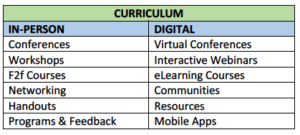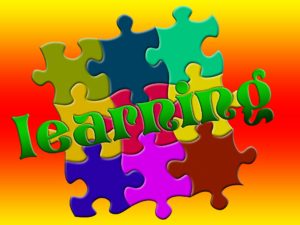The rush for the perfect learning management system began originally with the concept of an integrated learning system. In January 1994, Steven C. Mills discussed “integrated learning systems new technology for classrooms of the future” in the journal, TechTrends. One key aspect of the original ILS model was the management component. Today’s learning world requires management but more importantly tools that tap the capacity of digital.
In education, there are virtually as many ways to learn as there are learners. When you focus on professional development, the options can be described in two broad categories or platforms — in-person and online:
In-person is just as described, people gather in the same geographic location during the same timeframe for purposes of learning. These gatherings include annual conferences, workshops, seminars, meetings or other settings where people come together in person.
Online is learning via the Internet, either wired or wireless. More and more it is the latter as mobile devices, especially smartphones and other such tools, are available everywhere for almost everyone. Online provides a rich array of digital experiences.
Unified learning aligns professional education design, development, and delivery across two axes: curriculum and platforms. In the former, the host learning organization designs and develops standards-based curriculum including best practices. The quality curriculum is written, reviewed and updated regularly by experts and stakeholders in the field. There is documented professional consensus regarding standards, competencies, career requirements, goals, courses, learning experiences, and performance outcomes.
The second axis, platforms, refers to multiple options for delivery of the curriculum, thus creating a variety of learning experiences. Here are some options delivered via the two dominant platforms:

The options listed in the table just scratch the surface. When you mix in hybrid or blended learning plus the power of mobile, the choices expand exponentially. Robust systemic tools are required to develop, implement, and sustain such a standards-based professional education program.
For successful unified learning, services are required to support in-person and eLearning platforms: learning management, event registration, help desk, member or client database, and more. These services are much more than a learning management system. One multi-dimensional system is needed. Such a system becomes a “one-stop shop” for curriculum design, development, and delivery via various platforms.
A quality unified learning system provides tools and support for designer and learner: curriculum and course templates; delivery options, e.g., webinar platform, eLearning course tools, resource center, learning communities; help desk; alignment with member or client database; assessment and reporting tools; archives; and other features. The aligned learning system truly is unified, or as originally conceived, integrated for learning design, development, and delivery.
The unified learning system takes professional training to entirely new levels. As adult learning continues to take center stage in careers and beyond, the multi-function system grows in importance for learning organizations.
Join Lance Simon of iCohere and me in January 2016 as we explore strategic, responsive planning for unified learning design and delivery. Take your current in-person and eLearning to new levels through Unified Learning Design Strategic Planning. And experience a unified learning system at the same time!
Image by geralt (Gerd Altmann, Freiburg, Deutschland)
########

